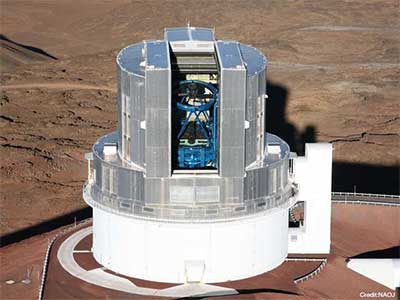Subaru Telescope
Subaru is an 8.2-meter optical-infrared telescope at the summit of Maunakea, Hawaii, operated by the National Astronomical Observatory of Japan (NAOJ), National Institutes of Natural Sciences. It is one of the largest optical-infrared telescopes in the world. The observatory of the Subaru Telescope was officially established in April 1997, following the completion of its base facility building in Hilo, Hawaii. "Subaru Telescope" can refer to the telescope itself or the entire observatory organization. Due to the difficulty of operating at high altitude, most of the support work for the telescope is conducted in Hilo by a staff of about 100 people. The Hilo Base Facility houses several research laboratories, a library, and extensive computing facilities including a supercomputer.
The Subaru Telescope was designed for long-term versatility as a major tool in observational astronomy, which focuses on the use of instruments mounted on the telescope to observe celestial objects. The sensors or detectors of the instruments capture light collected by the primary mirror and then convert it into a form that researchers can use as data in their computers. The instruments play a crucial role in the scientific process of feedback between observation, analysis and discovery, all of which contribute to an accurate, deep understanding of the Universe.
The relatively large numbers of instruments for the Subaru Telescope were carefully chosen and designed to allow for exploration of as wide a range of astronomical phenomena as possible, e.g., exoplanets, far-distant galaxies, dark energy, dark matter. The five cameras and spectrographs span optical and infrared wavelengths, which represent light at different points along the electromagnetic spectrum. Optical light is that part of the spectrum that is visible to and detectable by the human eye, while infrared light is not.
Two major scientific achievements of subaru telescope :
An international team of astronomers in India, Japan, the USA and other countries has discovered a new active galaxy identified as the farthest gamma-ray emitting active galaxy known to date using the infrared spectrometer MOIRCS mounted on the Subaru Telescope. These objects are special active galaxies observed through high-energy gamma-rays believed to be emitted from their relativistic jets. They are rare, only 16 examples are known so far. The distance to this newly found active galaxy is about 9 billion light-years corresponding to a redshift of 1.344. This is the first time such an object has been found at a redshift of greater than 1. This discovery opens new avenues to explore more such gamma-ray emitting galaxies in the early Universe.
An international collaboration of astronomers led by a researcher from the Astrobiology Center and Queen’s University Belfast has detected a new chemical signature in the atmosphere of an extrasolar planet – i.e., a planet that orbits a star other than our Sun. The hydroxyl radical (OH) was found on the dayside of the exoplanet WASP-33b. This planet is a so-called 'ultra-hot Jupiter', a gas-giant planet orbiting its host star much closer than Mercury orbits the Sun.









